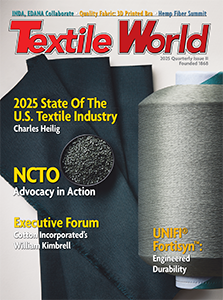RALEIGH, N.C. — December 6, 2016 — Governor Pat McCrory, North Carolina Commerce Secretary John E. Skvarla, III, and the Economic Development Partnership of North Carolina (EDPNC) announced today that Everest Textile USA will establish a 610-job manufacturing facility in Rutherford County. The Taiwan-based maker of high-performance sports apparel will invest $18.5 million over five years at a site in Forest City.
“North Carolina’s outstanding business climate offers great advantages to global manufacturers such as Everest Textiles,” said Governor McCrory. “We are thrilled that this innovation-based textile company has selected our state and its tradition of high-quality manufacturing to build its presence in the Americas.”
Since Governor McCrory entered office in January of 2013, North Carolina’s economy has generated more than 300,000 jobs.
Everest Textiles USA is a unit of Everest Textile Co., Ltd., headquartered in Tainan City, Taiwan. Founded in 1988, the publicly-held parent company (TWSE: 1460) is a vertically integrated developer and supplier of innovative products to leading brands in sports, casual and other apparel. Its buyers include names such as Nike, Columbia and Patagonia. Everest currently has factories in Taiwan, China and Thailand. Its Rutherford County plant will be its first outside Asia.
“North Carolina’s outstanding workforce, moderate cost-structure and engaged community colleges put us on the short list for 21st century manufacturers of every kind,” said Secretary Skvarla. “We have all the ingredients global companies need to succeed.”
The company plans to employ operators, supervisors and an administrative team. Once fully operational, the facility will add nearly $15.8 million annual payroll impact to the local economy.
“Everest positions itself as one of the leading global enterprises and commits to contribute to human society by providing innovative, environmentally friendly and comfortable textile products to the industry and consumers,” said Scott Chen, corporate vice president. “There is still a long way for us to go and your continuous support is essential. Trust we will all work together to make it happen.”
“As a native North Carolinian, it is exciting to see Everest Textile USA investing in the state and people of North Carolina, while also creating innovative products,” said Michael Chen, U.S. Legal Counsel to Everest Textile. “This project will be a tremendous opportunity for all parties involved.”
Everest’s arrival in Rutherford County will be facilitated, in part, by a Job Development Investment Grant (JDIG) approved by the state’s Economic Investment Committee earlier today. Under the terms of the company’s JDIG, the company is eligible to receive just over $3 million in total reimbursements. Payments will occur in annual installments over 12 years pending verification by NC Commerce and NC Revenue that the company has met incremental job creation and investment targets. JDIGs reimburse new and expanding companies a portion of the newly created tax-base with the goal of increasing the overall tax benefit to the State of North Carolina. By law, JDIG projects must result in a net revenue inflow to the state treasury over the life of the award. This project is contingent upon local participation from the county or municipality.
“I welcome Everest Textiles USA to Rutherford County and look forward to this R&D-intensive manufacturer creating jobs and becoming a visible part of our business community,” said State Senator Ralph Hise.
“The selection of Rutherford County for Everest’s first production site outside of Asia is clear evidence that western North Carolina is competitive with any region in the world when it comes to manufacturing,” said State Representative David Rogers. “I congratulate this growing company on its terrific choice and look forward to supporting its success.”
In facilitating Everest Textile’s announcement, North Carolina Commerce and EDPNC worked with the North Carolina General Assembly, the North Carolina Community College System, NCWorks, the North Carolina Department of Environmental Quality, Rutherford County, the Town of Forest City, the Rutherford County Economic Development Commission and North Carolina State University, and the North Carolina Taiwanese Chamber of Commerce.
Posted December 12, 2016
Source: govenor.nc.gov




